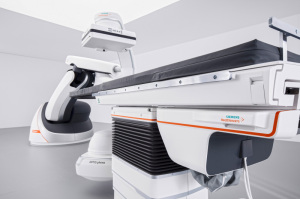Siemens unveils Artis pheno robotic angio system at RSNA
por
Lauren Dubinsky, Senior Reporter | November 27, 2016

Siemens' Artis pheno
Siemens Healthineers has introduced its next-generation robotic angiography system to the U.S. market at the annual meeting of the Radiological Society of North America in Chicago this week. The Artis zeego, which was introduced eight years ago, is the predecessor of the new Artis pheno.
“We are getting more flexible, especially in terms of challenging patients,” Peter Seitz, general manager of surgery, told HCB News. “Hospital systems around the world are facing more obese patients, older patients and fragile patients.”
Compared to the Artis zeego, full-body exams performed with the Artis pheno are 15 percent faster and head exams are 68 percent faster. Because of that, less contrast media is needed, which means that the exams will be safer for older patients with impaired kidney function.
The Artis pheno is also ideal for obese patients since the C-arm is 13 centimeters wider and has a free inner diameter of 95.5 centimeters. Siemens’ multi-tilt table is also able to accommodate patients who weight up to 280 kilograms.
Seitz believes that the largest trend in surgery at the moment is the shift from open procedures to minimally-invasive procedures. Aortic aneurysms have traditionally been open procedures, but now about 75 percent of those procedures are performed minimally-invasively, he added.
The Artis pheno can be paired with software applications to aid minimally-invasive spinal fusion procedures. Screw paths can be planned and the Automatic Path Alignment function automatically aligns the C-arm to follow them, which can lessen the rate of screw positioning errors.
The new system also supports transarterial chemoembolization of tumors. The procedure involves embolic particles coated with a chemotherapeutic drug being inserted through a catheter into the arteries and then the tumor.
With the syngo DynaCT 360, it only takes six seconds for the Artis pheno to create a large-volume image of the liver or lung. That includes the anatomy of the tumor and the vessels that lead to it.
“There is a high incentive for the hospital or health system to have minimally-invasive procedures which, in the end, save costs in the health care system,” said Seitz.
The Artis pheno was also designed with hygiene in mind. That’s more important than ever now that the Centers for Medicare and Medicaid is penalizing hospitals for hospital-acquired infections.
This is Siemens’ first system that has an anti-microbial painting. In the surgical environment fluids can attach to the equipment, but the painting reduces the probability of germs, according to Seitz.
The Artis zeego required cabling on the ceiling of the operating room, but the Artis pheno has no ceiling-mounted parts. All of the equipment is within the robot or in a cable ducts that are part of the robot.
“The ceiling is completely untouched by us,” said Seitz. “In a sterile environment that is extremely important.”
The Artis pheno was introduced in Europe at the German Congress for Orthopedics and Trauma Surgery last month. It’s not yet for sale in the U.S. and currently has not received 510(k) clearance from the FDA.
|
|
|
You Must Be Logged In To Post A Comment
|
